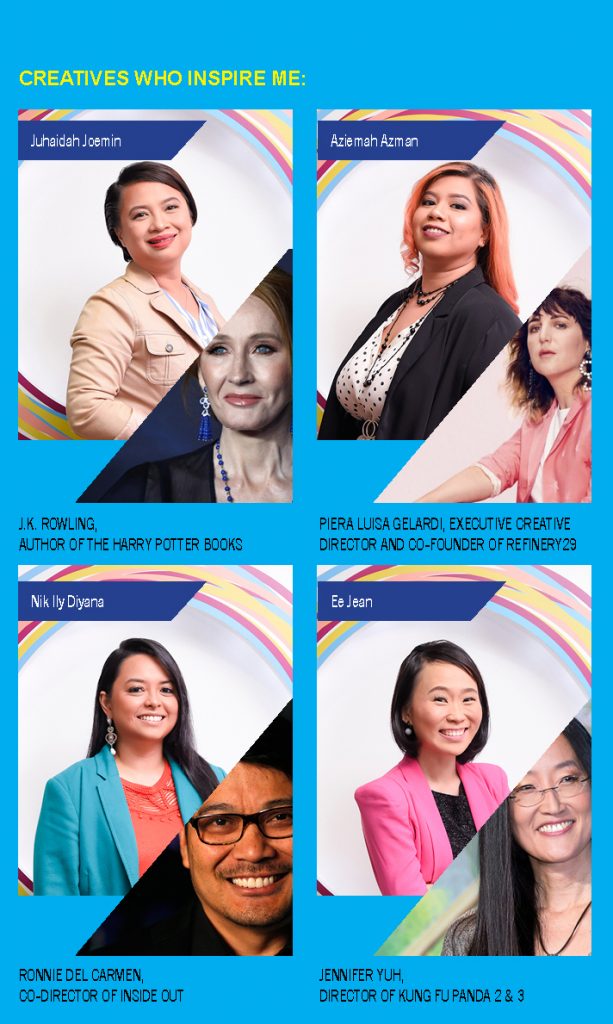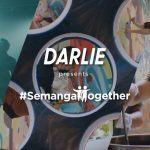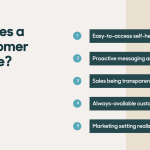[From Left] : Production Manager at Wau Animation, Salina Salmee Mohd Ali; Animation Director at Monsta, Yap Eejean; Manager of IP Animation at Primeworks Studios, Aziemah Azman; Managing Director & Executive Producer of Giggle Garage, Juhaidah Joemin; Head of Animation & Ecosystem Rollout at MDEC, Janice Lim; Manager of Licensing & Merchandising at Primeworks Studios, Nik Ily Diyana Nik Anuar and Senior Animator at Blindspot Studios, Siti Najihah.
Introduction to our Animation Industry
The animation industry isn’t unlike most global industries in that it faces a gender imbalance skewed towards men. In the case of Malaysia, a humble developing market in South-east Asia, which boasts of some incredible feats in the world of animation and visual effects work such as the award-winning film ‘Life of Pi’, one expects nothing dissimilar. However, contrasting the trend with much of its peers, Malaysia continues to bring her women to the fore.
Headlines were made in 2019 when ‘Ejen Ali’, an animated spy-fi action film produced by WAU Animation, became the highest grossing Malaysian film in 2019, following in the footsteps of cinema blockbusters ‘Upin & Ipin : Keris Siamang Tunggal’ and ‘BoboiBoy the Movie 2’ in the same year. The film was distributed by Primeworks Studios, the content creation subsidiary of Media Prima Berhad, Malaysia’s largest media conglomerate. Raking in more than RM 30 million, the film achieved the #3 spot in the list of highest-grossing Malaysian films of all time.
However, this booming industry has been successful even before the likes of ‘Ejen Ali’, ‘Upin & Ipin’ or ‘Boboiboy’. In 2011, ‘Saladin’ put Malaysia on the world map when it was nominated for the 39th International Emmy Awards under the Children & Young People Category. ‘Saladin’ was co-produced by Malaysia’s own Multimedia Development Corporation (MDEC), caretaker of the country’s MSC Malaysia initiative.
Behind the success that surrounds the industry is an ecosystem purpose-built to produce original creative content, making it one of the best in Southeast Asia. That ecosystem is led by women from various backgrounds, all united by their passion for creating.
I had the opportunity to sit down with seven women from the industry to get their thoughts on the industry’s gender imbalance, the challenges it faces and most importantly, their roles in its expansive growth.
A male-dominated industry
Studies have shown that the global animation industry lacks women, especially in key technical roles. However, quoting the 2018 Southeast Asia Animation report produced by MDEC, Janice Lim said, “Besides technical animation skills, there are actually many roles needed in the industry such as script-writing, voice acting, production management, compositing and designing.” She added, “Seeing that women make up almost 50% of the workforce, technically half of the jobs that exist within the industry should be for women.”
Janice, the Head of Animation & Ecosystem Rollout at MDEC, is part of the organisation’s Digital Creative Content division. An accountant by trade with an extensive IT background, she joined the MDEC team to support Malaysia’s rapidly maturing digital creative industry, which includes animation, movies and video games, highlighted as a significant growth driver for the nation.
According to advocacy group ‘Women in Animation’, 60% of animation students in the US and Europe are women, but the dropout rate as they move into industry is staggering, with only 20%–40% of professional roles held by women. So where are all the women? – I asked the seven women sitting across from me.
One of them was self-made Juhaidah Joemin, the Managing Director and Executive Producer at Giggle Garage; an animation studio that creates CGI animation series for kids and families around the world. Despite having more than two decades of experience in the industry, Juhaidah actually started off in college enrolled in a chemical engineering course.
“I always felt something was not right about it, but my father really wanted one of his children to pursue engineering,” she said. “On the other hand, I love watching movies and playing games, which is why three years into my course, when I saw the ad for an opening at University Telekom (now known as MMU) for VFX, animation and digital media studies, I went for it.”
Also starting off-course is Aziemah Azman, Manager of IP Animation at Primeworks Studios. Aziemah, whose professional background is a business degree in tourism management, had the opportunity to work with WAU Animation to co-produce ‘Ejen Ali: The Movie’. She says animation is almost “a stumbled-upon career”, as she initially joined Primeworks Studios in a marketing and communications role.
“I’m an avid reader, and through my love of stories, I like to explore the intricacies of why people do what they do,” she said. “Working with the WAU Animation team on Ejen Ali was a great experience with a steep learning curve, as I was able to work with like-minded people determined to not just create animation for kids to enjoy, but to create a story that even resonated with adults.”
Burgeoning from an almost unheard industry in the country to now more than a dozen companies operating as a provider for foreign entities; Malaysia’s animation industry’s further growth is especially noticeable in its evolvement from doing work for hire for other countries, to now becoming the leading country in the region for original Intellectual Property (IP). Despite the vastness of the industry, until recent times, it saw a gender imbalance.
The issue of gender imbalance in the industry itself is slowly becoming irrelevant in recent times. Was this always the case in its history? That’s a question best answered by veteran animators who have witnessed and been part of its different phases of growth.
“I’ve been in the industry for the last 13 years and for the last 10 years or so, the industry was going through a growth phase and it was tough for everyone,” said Yap Ee Jean, an Animation Director at Monsta. “That was when it was hard for women to sustain their dreams in the animation industry, but in the recent years we have seen this improve.” Monsta, also known as Animonsta Studios, is widely renowned for their first animation IP, ‘BoBoiBoy’.
According to Ee Jean, the industry requires a lot of time, dedication, commitment and long hours; which sometimes women aren’t able to sustain due to society’s expected gender roles – at times leaving them with no choice but to choose their commitment to their family over their career.
However, all seven women agreed that if a studio’s management makes the commitment to set-up a well managed production pipeline, more women would be encouraged to join in the workforce, because they are able to achieve work-life balance.
Besides the issue of time commitment, another factor to consider is the general lack of awareness regarding the industry itself. When the word animation is thrown out, most people think of designers, animators and VFX specialists, unless they know the industry better. However, the reality is, it takes a village to raise a child and the child in this case is an IP.
Janice, whose work with MDEC is to facilitate innovative growth in this sector, also agreed that the lack of exposure has been a challenge in getting women to join industry. Similar to most male-dominated roles, it is a classic lack of a ‘I see it therefore I can be it’ situation.
“It’s actually a very gender neutral environment in the animation industry, it’s whether you want to seize the opportunities that are available,” Janice added. “At MDEC, when we run programs, we try to make sure, wherever possible, to highlight the successes of women in the animation industry so that young girls have role models to look up to.”
MDEC provides animation studios with numerous support programmes including skills training. To ensure studios that put out good work see a follow-through to financial success, MDEC also provides them with market access; essentially hand-holding new companies to move on to the next stage.
10 years ago, when Giggle Garage came into existence, the studio also received support from MDEC. Juhaidah commented that the whole ecosystem is crucial for a country to have a successful animation industry.
“After receiving training, once we have the content idea, the next step is to find a partner to produce it and an audience to watch it,” Juhaidah explained. “That’s how Primeworks Studios came onboard, bringing along Media Prima’s vast network of platforms, and now we’re working together on a project to create our next original IP. An animation studio cannot exist alone, it needs the support of this ecosystem.”
Long working hours during the production season is a norm for this industry. According to Salina Salmee Mohd Ali, Production Manager with WAU Animation, when there are deadlines approaching, team members working on the project sometimes have to sleep in the office.
“When my team stays back, I have to as well,” she said. “It’s like an adult sleepover, except with your colleagues, and one time I even had to bring my children with me because deadlines are top priority.”
Salina’s role is to check the pipeline and workflow for the entire production and keep track of her team members’ deadlines.
On the other hand, senior animator at Blindspot Studios, Siti Najihah, calls herself a newbie, having 5 years worth of experience in the industry.
Both Salina and Najihah studied graphic and multimedia before their interest in animation took them down this road. For Salina, it was the ‘Upin & Ipin’ cartoons that inspired her to take up a 3-month 3D modelling course to give her the basics she needed.
Similarly, Najihah, after realising her interest in animation, sought out an academy to kickstart her learning in the animation production process. After completing an 11-month course, she was able to build a portfolio to impress the industry to hire her.

Industry and personal challenges
“While it is an industry of creating, animation is also a business and it needs to be run systematically as a business to sustain,” Janice said.
When talking about the challenges in the industry, Juhaidah admitted that the financial aspect is what comes to mind first. She added that studios in Malaysia are lucky that MDEC exists for companies like Giggle Garage to get support in terms of training and funding to produce IPs.
As a studio owner, Juhaidah emphasised that when going into the animation business, it is not enough to just focus on the creative and technical skills. She said it’s imperative to be aware of legal requirements such as how to protect your IP, as well as learning the financial aspects such as how to produce and fund your production, and then later on, how to market them locally and internationally.
“There is much to learn and you have to continuously keep yourself up-to-date due to the ever evolving landscape within the creative industry,” Juhaidah said. “I recommend doing a lot of research and if possible, to work with people who specialise in these areas.”
Najihah added that another thing to consider is the long hours required during production days, and these are the times when it would be easy to experience burnout. “It’s important to have a circle of friends who can empathise with you,” she said. For Najihah, she relies on the support of a circle of girl friends.
Looking beyond animation content
Another dimension to the animation industry, one that has helped even failed box offices to make a profit, is licensing and merchandising. Four years ago, when Media Prima was looking to diversify its business portfolio, Nik Ily Diyana Nik Anuar, Manager of Licensing & Merchandising at Primeworks Studios, was given the opportunity to build a new licensing business unit, along with the new IP Animation set-up. The move was an important investment in line with the studio’s vision of creating ‘Asian Stories for the World’, by tapping into regional content that can travel to find an international audience.
“When we began, it was an adventure like no other,” Diyana said. “Even though the licensing business isn’t a new concept in Malaysia, it was uncharted territory for us and for me and seeing it grow to where we are today has been very inspiring.”
Brand licensing is a business that banks on emotional engagement, and for Primeworks Studios, Diyana says they have been fortunate to work with talented storytellers to strengthen their IP offerings. The IPs are designed from the get-go to be easily translated into attractive products in the market, as well as campaigns with corporate partners.
“For example, during the highly successful ‘Ejen Ali the Movie’ release in December 2019, we partnered up with Tenaga Nasional Berhad (TNB) for a campaign to instil their 21 Energy Efficiency tips in Ejen Ali’s primary audience of 8 to 12 year-olds,” Diyana explained. “We built a secret agent-themed event where kids could complete a storied mission simulated to save energy usage and moving forward, we aim to work with property owners to build complete and profitable licensing programs while creating new avenues for marketing and promotions in Malaysia and beyond,” she added.
Hopes for the future
It is hard to view this industry as male dominated after meeting seven women who were not only passionate about their jobs, but also excellent at what they did; with their diverse leadership roles to prove it.
Yet the numbers cannot be ignored and the reality is, it is an industry that needs more women to participate. Besides creating a more gender-balanced environment, the participation of women in animation is crucial because it helps diversify the narrative that is imparted to the next generation.
For Aziemah, she hopes to see an increase in female participation so that more women-led stories are told. She acknowledged that the last three well-known Malaysian IPs all center around boys and whilst girls can also appreciate those, it is also important for young girls to see someone in a leading role on screen that they can relate and aspire to.
“On the international level, there’s ample choice for girl-centric animated content from the big studios,” Aziemah said. “However, I want to tell more diverse local female stories because we’ve been regaled with the classic princess sentiments for so long and while there is nothing wrong with that, I want to give our girls more options to aspire to instead of just domestic roles.”
Fundamentally, that is the importance of diversity. When you have both men and women leading the charge side by side on any team, it sparks creativity and innovation from different perspectives, adding layers and depth to the stories we tell.










